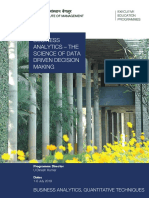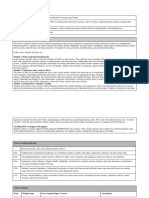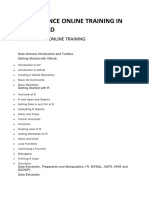0 ratings0% found this document useful (0 votes)
66 viewsPython Roadmap
Uploaded by
yashnikam844Copyright
© © All Rights Reserved
We take content rights seriously. If you suspect this is your content, claim it here.
Available Formats
Download as PDF, TXT or read online on Scribd
0 ratings0% found this document useful (0 votes)
66 viewsPython Roadmap
Uploaded by
yashnikam844Copyright
© © All Rights Reserved
We take content rights seriously. If you suspect this is your content, claim it here.
Available Formats
Download as PDF, TXT or read online on Scribd
You are on page 1/ 5
Creating a 30-day roadmap for learning Python for data analytics involves breaking down the key
concepts and skills into manageable daily goals. Here's a structured plan to guide you through the
process:
### Week 1: Introduction to Python and Basic Programming Concepts
**Day 1: Introduction to Python**
- Install Python and set up your development environment (Jupyter Notebook, VS Code, etc.)
- Learn about Python syntax, variables, and data types
**Day 2: Control Flow**
- Conditional statements (if, else, elif)
- Loops (for, while)
**Day 3: Functions**
- Defining and calling functions
- Parameters and return values
- Scope and lifetime of variables
**Day 4: Data Structures: Lists**
- Creating and accessing lists
- List methods and operations
- List comprehensions
**Day 5: Data Structures: Tuples and Sets**
- Creating and using tuples
- Creating and using sets
- Set operations
**Day 6: Data Structures: Dictionaries**
- Creating and accessing dictionaries
- Dictionary methods and operations
- Iterating through dictionaries
**Day 7: File Handling**
- Reading from and writing to files
- Working with different file formats (text, CSV)
### Week 2: Intermediate Python and Libraries for Data Analytics
**Day 8: Modules and Packages**
- Importing modules and using standard libraries
- Installing and using external packages (pip)
**Day 9: Introduction to NumPy**
- NumPy arrays and basic operations
- Indexing, slicing, and reshaping arrays
**Day 10: Advanced NumPy**
- Statistical operations with NumPy
- Broadcasting and vectorized operations
**Day 11: Introduction to Pandas**
- Pandas Series and DataFrames
- Loading data into Pandas (CSV, Excel, etc.)
**Day 12: Data Manipulation with Pandas**
- Data cleaning and preprocessing
- Filtering, sorting, and grouping data
**Day 13: Advanced Pandas**
- Merging and joining DataFrames
- Pivot tables and cross-tabulations
**Day 14: Data Visualization with Matplotlib**
- Basic plotting with Matplotlib
- Customizing plots (titles, labels, legends)
### Week 3: Advanced Data Analytics Techniques
**Day 15: Data Visualization with Seaborn**
- Advanced plotting with Seaborn
- Creating complex visualizations (heatmaps, pair plots)
**Day 16: Exploratory Data Analysis (EDA)**
- Descriptive statistics
- Identifying trends and patterns in data
**Day 17: Data Cleaning and Preparation**
- Handling missing values
- Data normalization and standardization
**Day 18: Introduction to SQL**
- Basic SQL queries
- Integrating SQL with Python (sqlite3, SQLAlchemy)
**Day 19: Web Scraping with BeautifulSoup**
- Basics of web scraping
- Extracting data from HTML pages
**Day 20: APIs and Data Extraction**
- Understanding APIs
- Making API requests and handling JSON data
**Day 21: Time Series Analysis**
- Working with datetime objects
- Basic time series analysis and visualization
### Week 4: Applied Data Analytics and Projects
**Day 22: Machine Learning Basics**
- Introduction to Scikit-Learn
- Simple linear regression
**Day 23: Machine Learning: Classification**
- Logistic regression
- Evaluating classification models
**Day 24: Machine Learning: Clustering**
- K-means clustering
- Evaluating clustering models
**Day 25: Machine Learning: Advanced Techniques**
- Decision trees and random forests
- Hyperparameter tuning
**Day 26: Natural Language Processing (NLP)**
- Basics of NLP with Python (nltk, spaCy)
- Text preprocessing and analysis
**Day 27: Working on a Mini Project**
- Choose a dataset
- Define the problem and apply data analytics techniques
**Day 28: Building a Dashboard**
- Introduction to dashboarding tools (Dash, Streamlit)
- Creating an interactive dashboard
**Day 29: Review and Refine Your Project**
- Review the code and results
- Refine and improve your analysis
**Day 30: Presentation and Next Steps**
- Present your project (write a report or create a presentation)
- Plan your next steps in learning data analytics (advanced topics, more projects)
This roadmap provides a structured way to learn and apply Python for data analytics. Each day's goal
is designed to build upon the previous one, ensuring a comprehensive understanding by the end of
the 30 days.
You might also like
- Business Analytics - The Science of Data Driven Decision Making PDF22% (9)Business Analytics - The Science of Data Driven Decision Making PDF3 pages
- Google Cloud Platform for Data Engineering: From Beginner to Data Engineer using Google Cloud PlatformFrom EverandGoogle Cloud Platform for Data Engineering: From Beginner to Data Engineer using Google Cloud Platform5/5 (1)
- PHD - Synopsis - in Geography-SVU - Joesph K. J0% (1)PHD - Synopsis - in Geography-SVU - Joesph K. J16 pages
- Data Analytics and Data Science Curiculam Google ADDSNo ratings yetData Analytics and Data Science Curiculam Google ADDS31 pages
- Non Tech Data Analytics Roadmap 1689017100No ratings yetNon Tech Data Analytics Roadmap 168901710010 pages
- Data Analysis and Data Science Course SyllabusNo ratings yetData Analysis and Data Science Course Syllabus4 pages
- Advance Big Data Science Using Python-R-Hadoop-Spark (1/3) : Total Duration: 90 Hours + PracticeNo ratings yetAdvance Big Data Science Using Python-R-Hadoop-Spark (1/3) : Total Duration: 90 Hours + Practice1 page
- 2 Weeks Data Science Using Python: Days TopicsNo ratings yet2 Weeks Data Science Using Python: Days Topics2 pages
- ? 90-Days Data Analyst Learning & Project Plan for PriyankaNo ratings yet? 90-Days Data Analyst Learning & Project Plan for Priyanka2 pages
- One Month Internship in DataScience With AIMLNo ratings yetOne Month Internship in DataScience With AIML3 pages
- 3-Months Roadmap To Become A Data Analyst in 2024No ratings yet3-Months Roadmap To Become A Data Analyst in 202411 pages
- Data Scientist Analyitcs Syllabus - Tech TransitionNo ratings yetData Scientist Analyitcs Syllabus - Tech Transition7 pages
- Microsoft SQL Server 2014 Business Intelligence Development Beginner’s GuideFrom EverandMicrosoft SQL Server 2014 Business Intelligence Development Beginner’s GuideNo ratings yet
- An Appraisal of Accounting System in The Public SectorNo ratings yetAn Appraisal of Accounting System in The Public Sector7 pages
- Pr2 Quarter 1 Nature of Inquiry and Research Lesson 1 Introduction To Qualitative ResearchNo ratings yetPr2 Quarter 1 Nature of Inquiry and Research Lesson 1 Introduction To Qualitative Research29 pages
- Chapter One 1.1 Background of The StudyNo ratings yetChapter One 1.1 Background of The Study37 pages
- Defining Business Analytics - An Empirical Approach PDFNo ratings yetDefining Business Analytics - An Empirical Approach PDF15 pages
- QBUS6840 Group Assignment (30 Marks) : 1 Background and TaskNo ratings yetQBUS6840 Group Assignment (30 Marks) : 1 Background and Task3 pages
- Rubrics For A Scientific Investigation ProjectNo ratings yetRubrics For A Scientific Investigation Project4 pages
- Merging - Scaled - 1D - & - Trying - Different - CLassification - ML - Models - .Ipynb - Colaboratory100% (1)Merging - Scaled - 1D - & - Trying - Different - CLassification - ML - Models - .Ipynb - Colaboratory16 pages
- Fraud Examiners Manual: (International Edition) InvestigationNo ratings yetFraud Examiners Manual: (International Edition) Investigation2 pages
- Data Analytics Report - Case Study - Employee Attrition100% (1)Data Analytics Report - Case Study - Employee Attrition41 pages
- An Empirical Survey on Social Media Usage Affect Academic PerformanceNo ratings yetAn Empirical Survey on Social Media Usage Affect Academic Performance12 pages

























































































